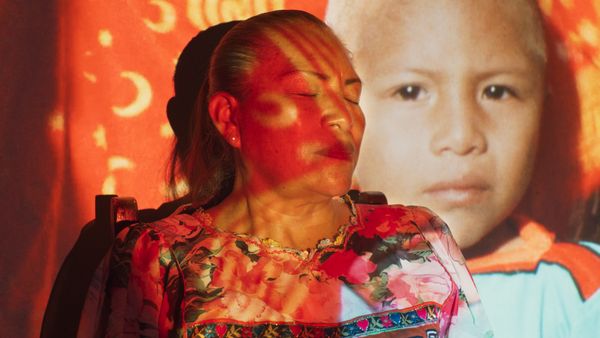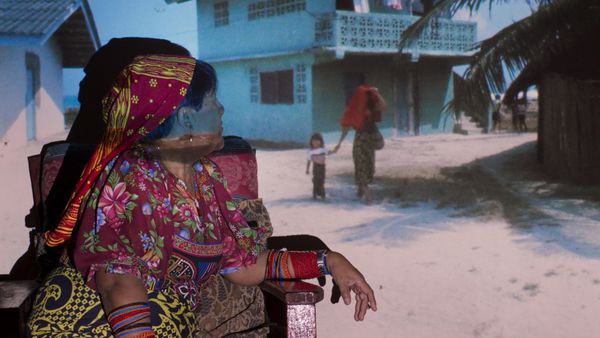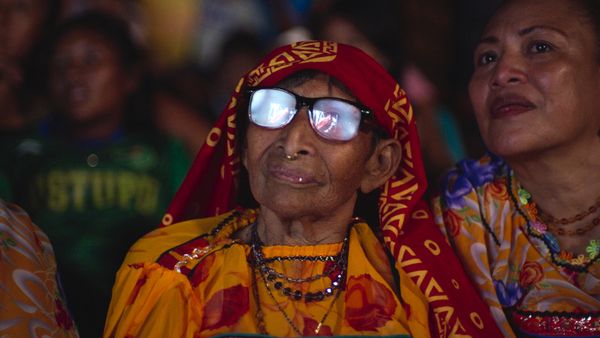 |
| Andres Peyrot on his faith that the original film would be found: 'I was crazy enough to believe deep down that moment would come just because the movie would be left so incomplete without it' |
The filmmaker, who has Swiss and Panamanian heritage, was drawn to the project while at a film festival in Panama in 2010. There, he met Orgun Wagua, who went on to be an executive producer of the film who invited him to meet his family on Ustupu, where Peyrot’s documentary unfolds.
Peyrot explains: “I knew that I was interested in making a film there in the community but I didn't have the exact precise idea yet. And I probably arrived a bit naively saying, ‘What an amazing place, it would be great to shoot a movie there’. And people started to make a joke, like, ‘Well, you know, you're not the first one to say this. We actually have this French guy who tried it 50 years ago, and it didn't end well at all’. It was a running joke during the trip. Then that joke then became something that was intriguing, and we started digging together and I realised that would be the story to tell, that was the angle that I was looking for.”
Six years after he started making the film, it had its premiere in Venice’s International Critics Week. When we caught up with him after the film’s premiere, we started by chatting about the shapeshifting nature of his film that was hit by tragedy as well as discovery after Turpana passed away..
“The movie definitely changed shape,” he says. “And it was rewritten as it was happening as obviously often happens with documentaries. We had some we had some difficult times where we were both really unsure that we would ever get to find the copy, it took a really long time to find a working copy. So the uncertainty around the project was big. And then losing, losing Turpana, who was meant to be the main person to tell this story as he was instrumental in the first shoots with Gaissea and then he's just such an incredible person and so important to the community.
 |
| Andres Peyrot |
“For me, personally, it was it was really losing a friend and losing how the movie was built up until that point. During the editing, being able to bring him back with the footage that we took during what, at the time, were more scouting trips, was really wonderful. I was happy to see that he could really be present in the first third of the film, which is something I wasn't sure would be the case.”
Peyrot’s film is partially about connection to a place we might call “home” but where we may no longer necessarily live. It’s particularly as we see some of the younger relatives of those who were in the original film returning to Ustupu to see it after two decades.
Peyrot says: “It was a very special feeling to experience and to feel, in the sense that I have a very small family, and people are quite spread out, so the sense of having a place that feels very much like home or community is not something that is very large in my surroundings. I think that I realise now, the creation of community, whether it's community, with friends, or fellow filmmakers, or other types of community, is something I cherish. Going there was very strong for me, an incredible feeling to, over the years, get to experience such a strong community and to feel the power of what a community can do and how, when everyone comes together there, there really are no limits.”
Another of the unusual ieas advanced in the film is hte idea of embracing technology and advancement as a way of preserving culture. There’s a touted notion that's present in the original film,that advancement in some way is destroying an existing culture, rather than treating it as fluid. Peyrot says this fluidity - which, of course, applies to all cultures - was something he wanted to explore going in.
He adds: “It's something that went even further than I had anticipated and that was really interesting. When I started the project, there wasn't yet an antenna installed to have high speed internet on the islands. That arrived during the filming. And it was really incredible to see that once the antenna was put in place, suddenly, all the cell phones had access to view anything that was online. But what was great was to see how especially Orgun thought it was a great tool to not just receive information, but start emitting videos and filming.
“He started setting up workshops across different islands saying, ‘We all have a filming device. Don't worry about having a big camera, worry about the story. Let's have a course on basic principles of shots, let's download an app to edit the film directly on our phones. Let's start telling our stories or let's start being the creators of our images’. And that was interesting because I could see in the community there was two schools of thought. Maybe some of the elders thought that it was potentially a bit destructive, or they saw it as, as the danger of just having all of the youth being glued to YouTube in Spanish or English. But for Orgun it was a tool to get the younger generation really interested again in the culture, just to receive it through different means. It really took off with the pandemic as well, because the islands were extremely locked down. That was a time where the community was very active, doing seminars, online forums, discussion panels with communities across Latin America. To see that that network take strength was really interesting.
 |
| God Is A Woman director Andres Peyrot: 'It's really about telling the personal and emotional journey of each character' |
“There is an indigenous term that they use to encompass this community that spans America. The indigenous communities of the continent they call Abya Yala.”
Peyrot’s film also interrogates the nature of subjectivity, particularly that of Gaissea, who imposes his own thoughts on the original film which are some distance from reality. I ask Peyrot if, because of this, he was conscious of his own inevitable subjectivity as well?
“It was a subject of discussion and something I was thinking about, throughout the process. I knew that it was impossible, obviously, not to have it, that doesn't really exist. So I thought of it more as a conversation.The other thing that was very important for me in making the movie was to never say anything that they're not sharing themselves directly, or that it's not said in a way that they want to say. So I knew that it was out of the question to put a voiceover or to put written text to explain anything, to try to give interpretation, even though that might leave some elements that require more explanation, maybe. Maybe you could say that about the revolution, there's so much to say about it, yet in the movie it is very impressionistic. You get to feel that it was an important moment, but you don't get to know a lot about it, or certain elements of the culture, you could go much more in depth. In the movie, it's really about telling the personal and emotional journey of each character. And then the part about diving into the culture, that's after the movie.”
In addition to inviting the audience to interrogate the subjective nature of documentary, it's clear through the course of the film that the Ustupu community itself begins to think about their own response to the contents of the film and their traditions. It also acts as a reminder that, wherever you live in the world, you tend not to consider your own culture very much because you’re just living within it. But the presence of the documentarian having a dialogue encourages a consideration of heritage.
“What was really nice was that in the community, there's a lot of humour. So we were able to discuss important topics with a bit of humour and distance and we were able to laugh at ourselves and others in a dialogue that was very fluid. It felt like an important subject, but not necessarily a serious one.”
Peyrot says he had faith from the start that they would unearth Gaissea’s original film.
“I was crazy enough to believe deep down that moment would come just because the movie would be left so incomplete without it,” he says.
He adds: “The big surprise, let’s say, was how in good shape it was. I thought that we were going to find something. I think we were determined that something had to be found. And in the worst case, it would be beautiful and poetic in its own way to have images that are completely damaged by time but something was going to be found and we were going to look at that. But when we finally found the film, it was incredibly emotional and a happy moment but also to see the quality and to see how well preserved the images were, that was a huge surprise.
“There were surprises that went beyond the movie. It was so touching to find the film that Gaissea shot of his daughter Akiko and all the extra rushes. We were able to explore all of the different textures and how they're part of the story, part of the passing of time. I find very powerful in the movie where Turpana says, ‘This is a film that suffered a lot’. And to see the texture in terms of scars and scratches and just how it tells of everything it has gone through it is a movie that has suffered, and it’s great to see it, come back and be able to, in a way heal, heal itself and have a new life.”






















